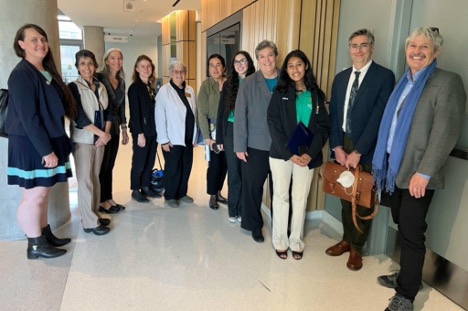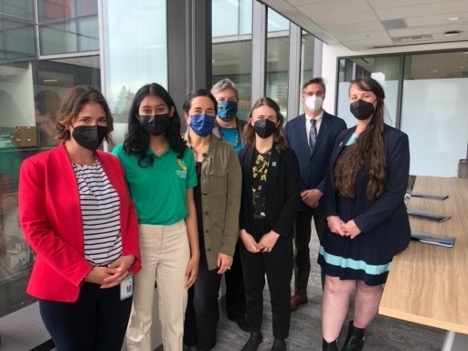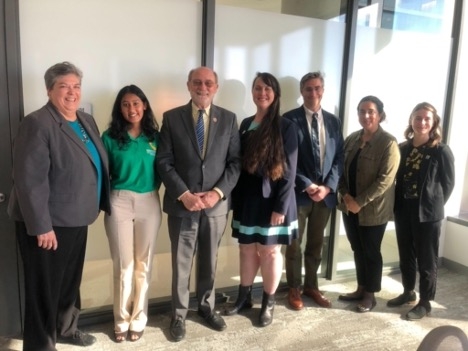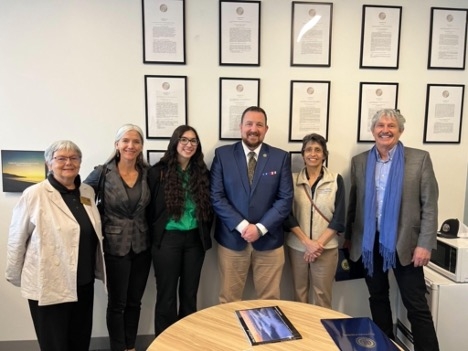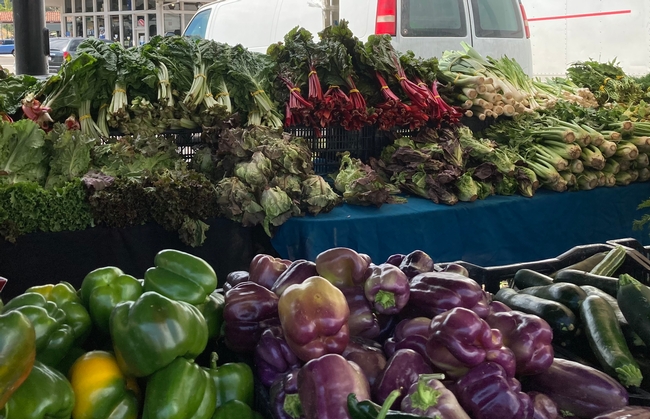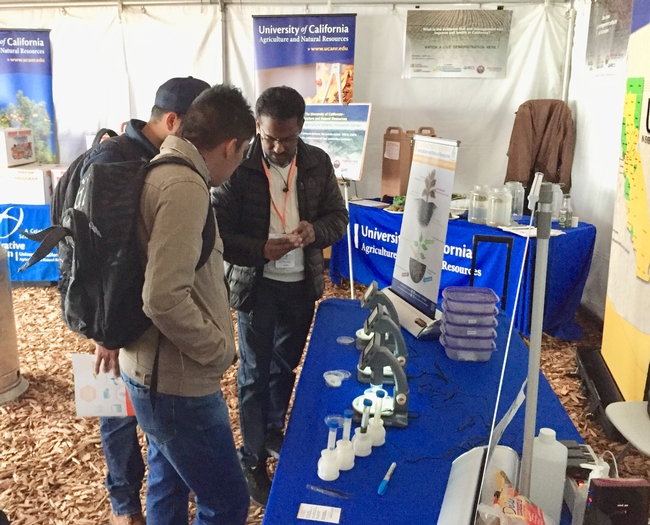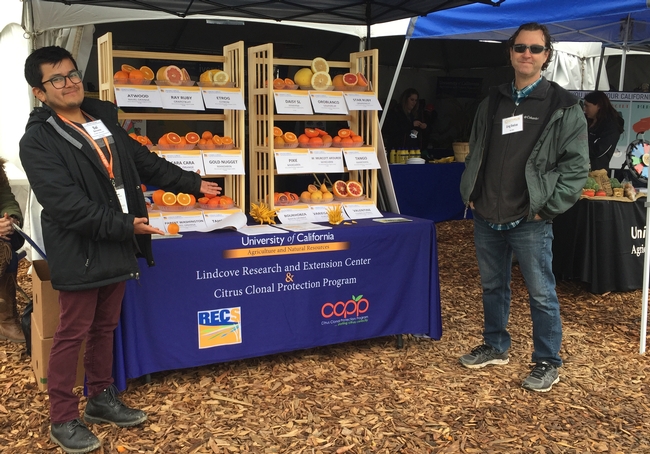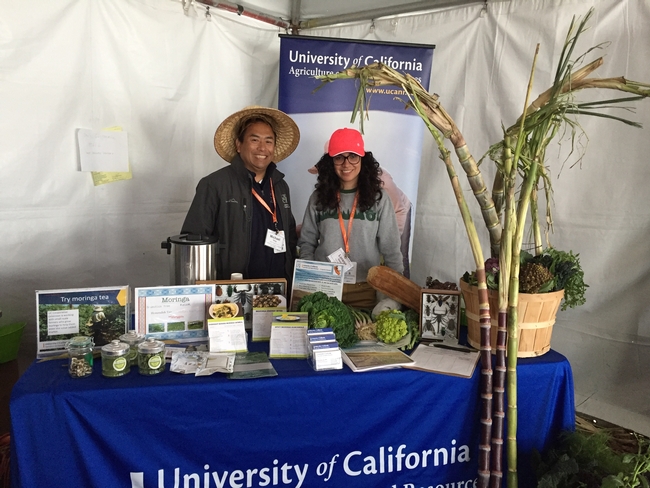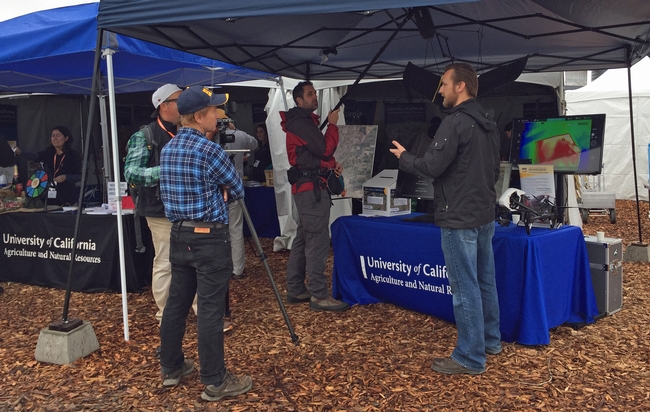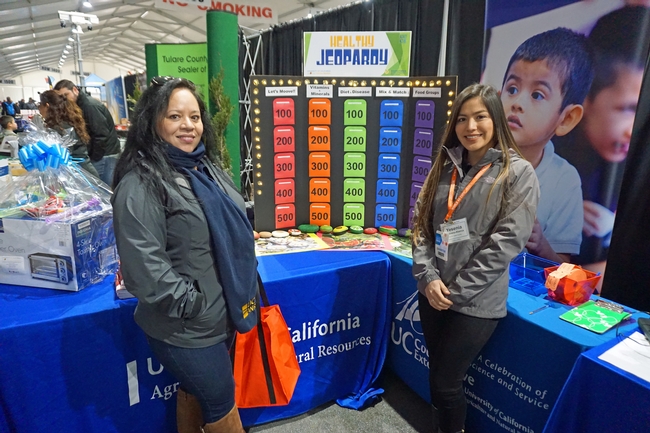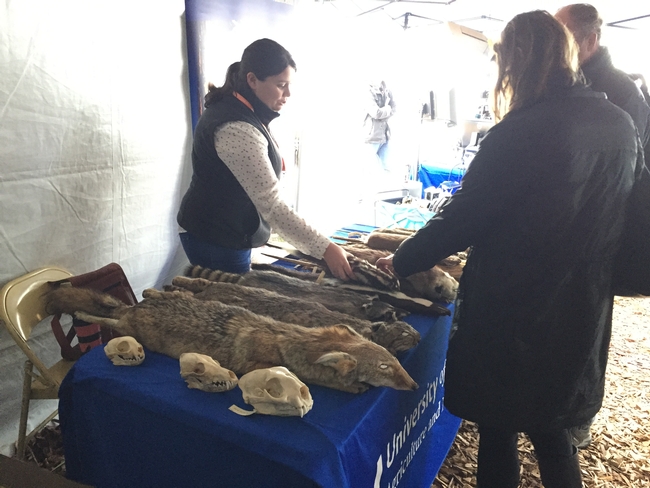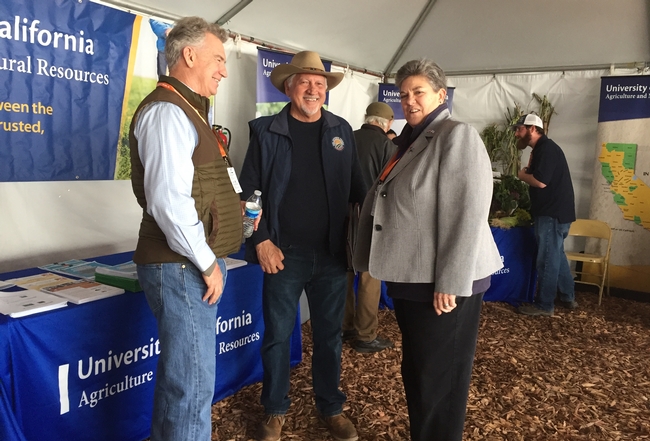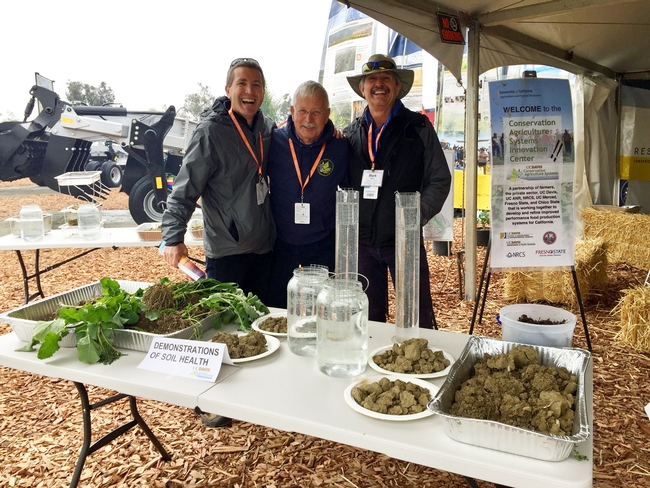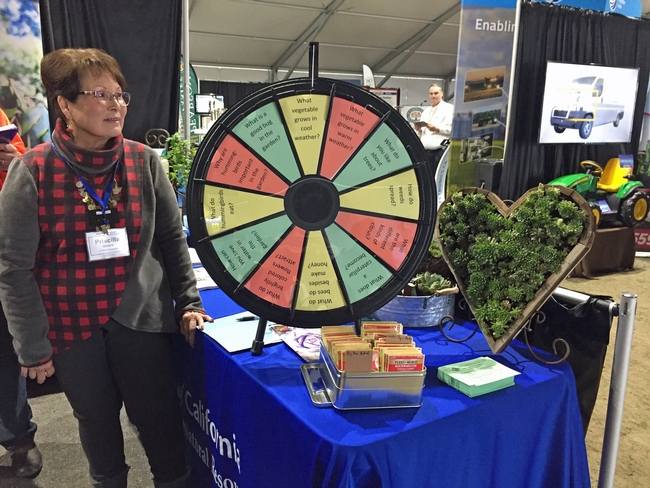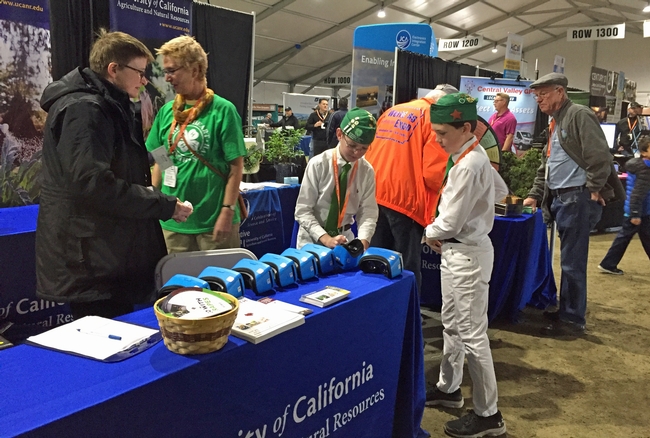Posts Tagged: Mark Bell
Delegation meets legislators for UC ANR Advocacy Day
A delegation of 12 UC ANR staff, academics, volunteers and stakeholders visited state legislators in Sacramento on April 19 for UC ANR Advocacy Day to share how UC ANR's work delivers local, place-based education, outreach and programming to serve communities throughout the state.
Anne Megaro, government and community relations director, and Christina Harrington, student assistant, UC Master Gardener and graduate of the UC California Naturalist Program, organized meetings with Assembly Member Rebecca Bauer-Kahan, Senator John Laird, Assembly Member Devon Mathis, and staff members in many legislative offices.
The delegation thanked them for investing in ongoing funding in last year's state budget and shared their stories of serving community members, farmers, ranchers, youth and natural resource managers in their regions.
Vice President Glenda Humiston and Mark Bell, Vice Provost of Strategic Initiatives and Statewide Programs, led two teams, which included Sarah-Mae Nelson, UC Climate Stewards initiative academic coordinator; Kamal Khaira, director of CalFresh Healthy Living, UC; UCCE advisors Igor Lacan, Mae Culumber and Dorina Espinoza; 4-H Youth State Ambassadors Megna Nayar and Sara Tibbets; and Clio Tarazi, UC Master Gardener volunteer.
The teams urged legislators to support several key budget requests as part of Governor Newsom's proposed FY 2022-23 state budget. These budget commitments would support UC's much-needed capital projects at Research and Extension Centers and Elkus Ranch to expand capacity for research and programming, as well as investments for UC climate action and resiliency projects that will advance climate research and workforce development programs for students and community members.
The UC ANR representatives invited the legislators to visit for tours and events to see UC ANR at work in their districts firsthand.
Strategic Initiative Brief: Small grants for webinars
Unify-Communicate-Advocate
The Strategic Initiatives offer a home for strategic thought - drawing on members of the wider UC ANR community and beyond to identify and address issues of current and emerging importance.
Strategic issues Spotlight webinar series going strong
Building Resilient Food Systems
The food systems series being coordinated by the Healthy Families and Communities and Sustainable Food Systems Strategic Initiatives continues to explore how to re-imagine our food systems. Sign up below and join us for the remaining webinars on the second and fourth Tuesday of each month through at least November to continue the discussion. Please let us know if you're interested in providing leadership or participating in a webinar for this series.
Contacts: Deanne Meyer (SFS SI leader) and Lynn Schmitt McQuitty (HFC SI leader)
July | Webinar #1 - Food Safety and COVID-19 (video) Slides (PDF) Resource Kit (PDF)
July | Webinar #2 - California Food Systems: Partnerships and Resources (video) Slides (PDF) Resource Kit (PDF)
August | Webinar #3 - The Ins and Outs of Niche Marketing Meat (video) Slides (PDF) Resource Kit (PDF)
August | Webinar #4 - Beef Supply Chain and Market Disruptions (video) Slides (PDF) Resource Kit (PDF)
September | Webinar #5 - Thinking Inside the Box: Farm Boxes and Local Supply Chain Resilience During the Pandemic(video) Slides (PDF) Resource Kit (PDF)
September | Webinar #6 - Victory Gardens Then and Now (video) Slides (PDF)
Oct. 13, 2020 | Webinar #7 - Increasing Resiliency of Farmers' Markets and Equitable Access to Fresh, Local Produce Register here
Oct. 27, 2020 | Webinar #8 - Re-imagining Food Systems: Emerging Strategies for Regional Food Systems Resulting from COVID-19 Register here
Nov. 10, 2020 | Webinar #9 - Farm Labor During the Pandemic: Critical links between Essential Work, Farmworker Health and Food System Resiliency Register here
Nov. 24, 2020 | Webinar #10 Register here
Visit the Spotlight webinars page to see recordings.
Managing Invasive Pests (in the pipeline)
Invasive pests can affect almost all aspects of our lives - our gardens, our communities, our food systems, our natural ecosystems. The Endemic and Invasive Pest & Diseases SI (EIPD) is in the process of designing a multi-part webinar series to help us understand pest quarantine regulations and reporting processes, permit requirements for moving pests, and extension's role in working with regulators and clientele. Stay tuned to hear more.
Contact: Jim Farrar
Our virtual reach continues to grow
SI partial funding support for webinars: The SIs are offering partial webinar support (up to $200) for webinars on topics consistent with the major SI strategic themes. Learn more here: Funding opportunities
Ever wondered about Adult learning principles and how they can help you in your job? Learn more here: Adult learning principles
Other resources
Online courses: Check out the recently developed Checklist: online course minimum standards
Video: Develop your "How-to" video making skills
Virtual Consultations: Get some Virtual consultation tips
Webinars: Pick up some pointers from the engaging webinars checklist or explore deeper to develop your webinar skills.
Online on-demand programmatic Online Orientation materials. Comments/feedback welcome.
All these materials have been developed with input from many, many colleagues. Please let us know what skills or tips you found useful and what more you'd like to learn.
In the pipeline
In the discussion pipeline, we have:
Remaining Relevant - Extension of the future: How do we meet the needs of all Californians? How do we address urban and DEI needs? What could post-COVID tertiary education look like, and what could be the role of UC ANR (re: working with community colleges, CSUs, UCs, internships…)? What other Funding & Incomes models are there?
Disaster response: How to contribute and position ourselves for broader impact - recognizing the tremendous progress made by the Fire group.
Engaging Program Teams and the wider body of UC ANR
COVID-19 is having us explore our virtual delivery options.
For more on the SIs and their activities, contact
Jim Farrar (EIPD)
David Lewis (Water)
David Lile (SNE)
Deanne Meyer (SFS)
Lynn Schmitt-McQuitty (HFC)
Mark Bell (Strategic Initiatives and Statewide Programs)
Workgroups, program teams and strategic initiatives review shows clarity of purpose
A major factor in job satisfaction is the extent to which people feel part of a wider supportive community. Such connections have historically been offered in UC ANR through various means, including our structural units (i.e., our 81 workgroups, 21 program teams and 5 strategic initiatives).
Healthy organizations should regularly look at their structure. Important elements of structure include how the pieces fit together and how people may better connect to more effectively implement their work. In the summer of 2018, we began a series of discussions and surveys to revisit aspects of our structure.
Thank you to the 120-plus people who provided input on our structure and suggestions regarding how we may connect.
Findings
1. Clarity of purpose:
The seeming fuzziness of the roles and goals of our workgroups (WGs), program teams (PTs) and strategic initiatives (SIs) is not as great as people may think. Many consistent findings arose across the different structural groups. A summary of our findings follows.
Workgroups (our oldest unit of structure) are the most readily understood. They represent active “communities of practice” (that can come and go) and are the primary place where people plan and implement (noting that such groups are both formal and informal).
One point of interest is that people didn't realize they could close or start workgroups as needed.
Program teams bring together people (typically from different workgroups) who are working on related but distinctly different topics to network, share and learn.
One clear observation is that PTs vary considerably in terms of the diversity of WG representation (e.g., 1 PT has 12 WGs and a few PTs have just 1 WG).
SIs are our highest form of aggregation (and currently the one that enjoys the least clarity). They function to unify, communicate and advocate as the umbrellas for the work we do. The recent addition for the SIs is the development of the focal areas and grand challenges, providing the opportunity to see the unifying focus in our efforts.
For more information about how workgroups, program teams and strategic initiatives fit together, see https://ucanr.edu/sites/StrategicInitiatives/files/295191.pdf.
2. Workgroups – Don't fix it if it ain't broken:
Of the 81 workgroups, 21 are considered very active and effective - while another 29 are somewhat active and 3 are new in 2019. The remaining 28 WGs have been inactive, as reflected by personnel or goal changes and will be officially closed (see list below). These can be easily reopened if demand arises.
The goal is for WGs to align with a single PT, which likely means realigning the PTs - see point No. 3 below. Currently some workgroups have no PT, whereas other WGs have aligned with many PTs.
3. Reformulate the topic areas for program teams:
The next step is to collect input and look at reformulating/reaffirming the PT themes. Currently, we have 21 PT themes. Some have no WGs under them. Others have many WGs under them. Some workgroups have aligned under many PTs, which creates uneven structure and at times uneven activity.
As we go forward, we encourage people to identify PT themes to 1) better represent the collective work of UC ANR, 2) create or show clearer paths for people to connect at the WG, PT and SI levels, and 3) help us refine the SI focal areas and grand challenges – providing greater clarity of our efforts and clearer SI alignment with the reformulated PT themes and WG efforts.
Opportunity for more input on PT themes
The PT discussions will include a webinar and county visits over summer.
Thank you all for your efforts and we welcome input.
Sincerely,
Mark Bell (Vice Provost Strategic Initiatives and Statewide Programs)
Strategic Initiative Leaders
HFC: Lynn Schmitt-McQuitty
SFS: Deanne Meyer and Neil McRoberts
Water: David Lewis
SNE: David Lile
Pests: Jim Farrar
—————————————
Workgroups to close. Note: If there is interest and leadership, workgroups can be readily opened by this simple new workgroup request.
1. Air Quality
2. Animals in Educational Settings
3. Bioenergy
4. Body Weight and Health
5. Building Food Security
6. Conservation Biology
7. Dairy Goats
8. Ecological Restoration
9. Economics and Management in Food, Agriculture, Natural Resources and the Environment
10. Environmental Observation Network
11. European Pear
12. Exotic Fruit Fly
13. Garden-based Learning
14. Health Promotion & Disease Prevention
15. Mosquito Research and Extension
16. Pest Management in ANR
17. Postharvest Integrated Pest Management
18. Rangeland Watershed Program
19. Turfgrass
20. Urban Horticulture
21. Water Quality
22. Woody Biomass Utilization
23. Families with Young Children
24. Food Safety Horticultural Crops
25. Land Use
26. Linking Research & Education in Agricultural & Environmental Biotechnology
27. Peppers
28. Spray Application Technology
ANR meets the public at World Ag Expo
People from across California and around the world got to taste new crops, see research demonstrations and learn about several UC ANR activities at the World Ag Expo Feb. 12-14. Despite the cold rainy weather, the world's largest agricultural exposition attracted 102,878 people representing 48 states, the District of Columbia and 65 countries to Tulare.
At an outdoor tent, Beth Grafton-Cardwell, UC Cooperative Extension specialist, Greg Douhan, UCCE citrus advisor, and other researchers, handed visitors fresh Tango citrus grown at the Lindcove Research and Extension Center and told them about their citrus variety research.
Ruth Dahlquist-Willard, UCCE small farms advisor, and Michael Yang, small farms and specialty crops agricultural assistant, encouraged visitors to taste moringa tea. Surendra Dara, UCCE entomology and biologicals advisor, described how Bagrada bugs and other pests under the microscopes can be controlled by microbes. Roger Baldwin, UCCE wildlife specialist, and Niamh Quinn, UCCE urban wildlife conflict advisor, took turns showing taxidermy vertebrate pests and describing their management research.
Jeff Mitchell, UCCE specialist, and Jeff Dahlberg, Kearney Agricultural Research and Extension Center director, gave demonstrations to show the superior health of soils managed with conservation techniques.
Demonstrating the use of high-tech in agriculture, Sean Hogan, Informatics and Geographic Information System academic coordinator, Andy Lyons, IGIS program coordinator, and Jacob Flanagan, IGIS programmer, showed how they use drones and cameras in agricultural research.
Inside Pavilion A, Teresa Rios-Spicer, UCCE nutrition program manager, andYeseniaMedrano, UCCE community education specialist, both from Tulare County, challenged visitors to test their nutrition knowledge by playing Jeopardy! Visitors could spin the UC Master Gardeners prize wheel to answer gardening questions and win seeds. 4-H members invited youth to peer into virtual reality goggles to give them an idea about the fun activities that can be part of joining 4-H.
Frank Mitloehner, UC Cooperative Extension specialist, gave a seminar explaining confusion in the media about the amount of greenhouse gas livestock emit in California and globally. He reviewed the innovations in livestock production that are leading the way to a "greener future" for California and U.S. agriculture.
Beth Grafton-Cardwell, UC Cooperative Extension citrus entomology specialist, and Victoria Hornbaker of the California Department of Food and Agriculture, gave an update on regulatory protocols relating to Asian citrus psyllid and HLB quarantines and the proper transportation of bulk citrus to prevent the spread of the pest and disease.
The California and Dutch AgFoodTech innovation partners reunited in Tulare for a networking luncheon to share their action plan with invited guests and scope the projects.
Apply by Nov. 9 to be SI leader for Water or Healthy Families and Communities
ANR academics are invited to apply for Strategic Initiative leader positions, which play key roles in unifying, communicating and advocating to strengthen UC ANR's research and outreach agenda. Given the ongoing evolving role of the UC ANR Strategic Initiatives (SI), the SI leaders agreed that it would again be beneficial to conduct an open search – from across the breadth of expertise of the division – for the next rotation of SI leaders.
Open Positions. Two SI leader positions are scheduled to rotate off at the end of 2018. This change offers opportunities for others to take the lead for
Who is eligible to apply? The positions are open to all UC ANR academics, including Agricultural Experiment Station faculty and Cooperative Extension advisors and specialists. Strategic Initiative leaders are appointed by the Associate Vice President on a rotating basis for three years, with a possibility of extension.
Current SI leaders
- Endemic and Invasive Pests and Diseases Jim Farrar
- Sustainable Food Systems Deanne Meyer and Neil McRoberts
- Sustainable Natural Resources David Lile
- Water Quality, Quantity and Security Doug Parker
- Healthy Families and Communities Keith Nathaniel
The SIs help unify, communicate and advocate for what UC ANR does. See the UCANR Strategic Initiatives website for more information.
To apply for one of the SI leader positions, complete the simple form at http://ucanr.edu/survey/survey.cfm?surveynumber=25782. Applications will be accepted until Nov. 9.
Applicants will be contacted for interviews in late November or early December. The new leaders are anticipated to start on Jan. 2, 2019.
For information regarding the roles and responsibilities of the Strategic Initiative leader position, see the Terms of Reference for Strategic Initiative Leaders. If you have questions, contact Mark Bell, vice provost of Strategic Initiatives and Statewide Programs.

